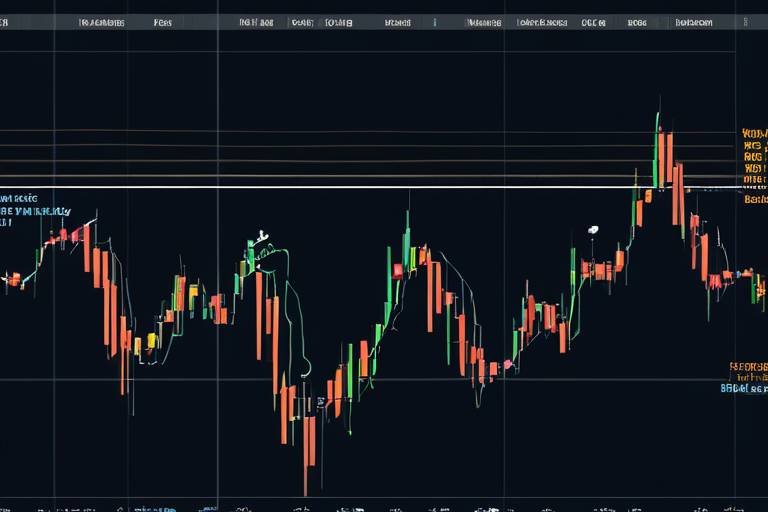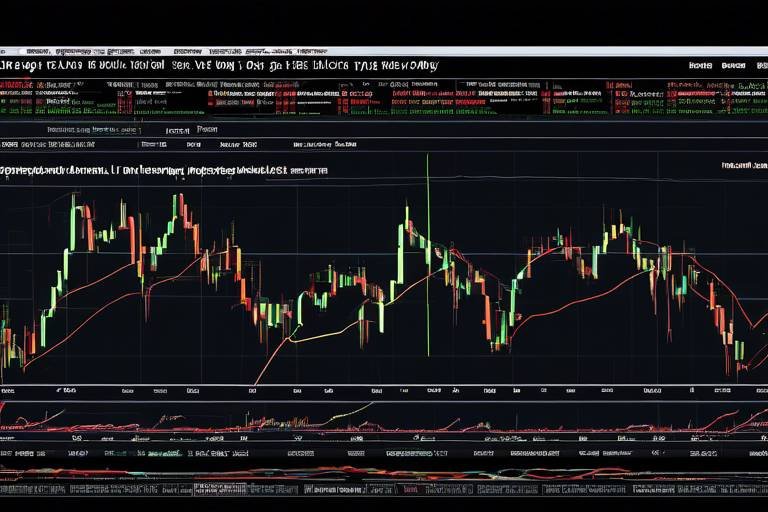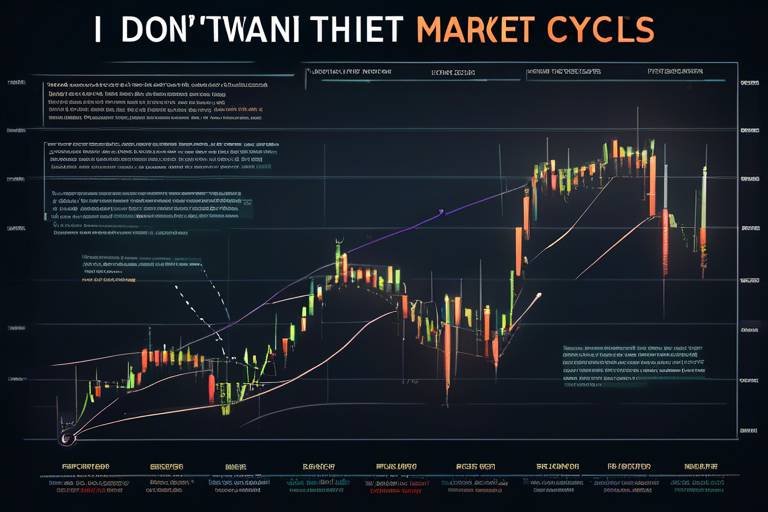How to Create a Crypto Trading Group
Creating a crypto trading group can be an exhilarating journey, filled with opportunities for learning, sharing, and earning together. Imagine a vibrant community where everyone is passionate about cryptocurrency, pooling their knowledge and strategies to navigate the often tumultuous waters of the crypto market. But how do you get started? What steps should you take to ensure your group is not just another chat room, but a thriving hub of collaboration and success? In this article, we’ll explore the essential steps and strategies for forming a successful crypto trading group, focusing on organization, communication, and fostering a collaborative environment among members.
Establishing a clear purpose is crucial for your crypto trading group. Without a defined goal, members may feel lost or disengaged. So, what do you want to achieve? Are you looking to educate newcomers about the basics of trading, share advanced trading strategies, or focus on collective investment opportunities? Clarifying your group's mission can help attract like-minded individuals who share your vision. Think of it as setting the sails for your ship; without a clear direction, you may drift aimlessly. Here are some common purposes for crypto trading groups:
- Education: Teach members about market trends, trading tools, and strategies.
- Strategy Sharing: Discuss different trading strategies and their effectiveness.
- Investment Opportunities: Identify and analyze promising investment options together.
Once you've defined your group's purpose, the next step is to select the appropriate platform for communication and trading. The right platform can make a world of difference in how effectively your group interacts and shares information. Think of it as choosing the right venue for a concert; the right space can enhance the experience for everyone involved. Here, we discuss various platforms, their features, and how to choose one that suits your group's needs.
When it comes to communication tools, there are several popular options that can enhance your group's interaction:
- Discord: Known for its voice and video chat capabilities, Discord allows for real-time discussions and is great for larger groups.
- Telegram: A favorite among crypto enthusiasts, Telegram offers robust security features and channels for broadcasting messages to large audiences.
- Slack: Ideal for more professional settings, Slack integrates with various tools and allows for organized discussions in different channels.
Creating specific channels for different topics can streamline discussions and keep information organized. For instance, you might establish channels for trading alerts, market news, and educational resources. This way, members can easily find the information they need without sifting through unrelated conversations. Think of it as organizing a library; the easier it is to find a book, the more likely people are to read!
Effective notification management ensures that members stay informed without feeling overwhelmed. Imagine being bombarded with messages every few minutes; it can quickly become exhausting and lead to disengagement. Learn how to balance alerts and updates to maintain engagement. You might consider setting guidelines for when to send notifications or using features that allow members to customize their notification preferences.
Discussing and selecting trading strategies as a group can enhance decision-making and foster a sense of community. Different members may have unique insights and experiences that can contribute to a more comprehensive understanding of the market. This collaborative approach can lead to better-informed decisions and potentially higher returns. Consider exploring various strategies such as day trading, swing trading, or long-term investing, and aligning them with your group’s collective knowledge and goals.
Fostering a supportive culture is key to a thriving crypto trading group. Just like a garden needs nurturing to flourish, your group needs encouragement and respect among its members. Here are some ways to promote a positive culture:
- Encouraging Participation: Active participation is essential for group success. Discover techniques to motivate members to share insights, experiences, and strategies regularly.
- Handling Conflicts: Conflicts may arise in any group. This section offers strategies for effectively managing disagreements and maintaining a positive group dynamic.
Security is paramount in crypto trading. With the rise of cyber threats and scams, it's crucial to prioritize the safety of your group's information and trading activities. Educating members about security protocols helps prevent breaches and ensures a safe trading environment for all. This emphasis on security can build trust within your community, making it a more inviting space for new members.
Educating members about security protocols helps prevent breaches. This section emphasizes the importance of awareness and training in safeguarding assets and personal information. Consider hosting workshops or sharing resources on best practices for online security, such as using two-factor authentication and recognizing phishing attempts.
Choosing secure trading platforms is critical. Explore the features that enhance security and the importance of due diligence when selecting where to trade. Just like you wouldn’t store your valuables in an unsecured location, you should ensure that your trading activities are conducted on reputable and secure platforms.
As you embark on this exciting journey of creating a crypto trading group, you may have some questions. Here are a few frequently asked questions that can help guide you:
- What is the best platform for a crypto trading group? The best platform depends on your group's needs, but popular options include Discord, Telegram, and Slack.
- How do I keep members engaged? Encourage participation through regular discussions, educational content, and by fostering a supportive community culture.
- What security measures should we implement? Educate members on security protocols, use secure platforms, and regularly review your group's security practices.

Defining the Purpose of Your Group
Establishing a clear purpose for your crypto trading group is like laying the foundation of a house; without it, everything else can crumble. So, what do you want to achieve? Are you aiming for a space where members can learn about cryptocurrency, share trading strategies, or perhaps find investment opportunities? Understanding the primary goals of your group will not only help you attract the right members but also guide your discussions and activities.
When defining your group's purpose, consider the following key objectives:
- Education: Are you looking to educate your members about the basics of cryptocurrency? This could include everything from blockchain technology to market trends.
- Strategy Development: Is your focus on creating and refining trading strategies? This could involve backtesting strategies, discussing market indicators, and sharing insights.
- Investment Opportunities: Do you want to explore potential investment opportunities together? This could mean analyzing different cryptocurrencies or evaluating ICOs.
Once you've identified your primary goals, it's essential to communicate them effectively to all members. This ensures everyone is on the same page and knows what to expect from the group. You might want to create a mission statement that encapsulates your objectives succinctly. For example, a mission statement could read: "Our group aims to foster an inclusive environment where members can learn, share, and grow their crypto trading skills together." This not only sets the tone for the group but also serves as a reminder of your collective purpose.
Additionally, consider the demographics of your group members. Are they beginners, seasoned traders, or somewhere in between? Tailoring your group's purpose to fit the skill levels and interests of your members can significantly enhance engagement and participation. For instance, if most of your members are new to crypto, focusing on educational resources and beginner-friendly strategies would be beneficial.
In conclusion, defining the purpose of your crypto trading group is a crucial step that will shape its future. By establishing clear objectives, communicating them effectively, and tailoring your approach to fit your members' needs, you'll create a vibrant community that thrives on collaboration and shared knowledge. Remember, a well-defined purpose acts as your group's compass, guiding you through the ever-changing landscape of cryptocurrency trading.

Choosing the Right Platform
When it comes to forming a successful crypto trading group, one of the most important decisions you'll make is choosing the right platform for communication and trading. Think of it as selecting the foundation for a house; if the foundation isn't solid, everything built on top of it is at risk. You need a platform that not only facilitates trading but also encourages interaction and collaboration among group members. This section will guide you through various platforms available, highlighting their features to help you make an informed decision that aligns with your group's needs.
First, consider what features are essential for your group. Do you need real-time chat capabilities? Are video calls a priority for discussing strategies? Or perhaps you require file sharing for educational resources? Each platform has its unique strengths and weaknesses. For example, some platforms are optimized for trading, while others focus on communication. To help you visualize this, here’s a simple comparison table:
| Platform | Primary Focus | Key Features |
|---|---|---|
| Discord | Communication | Voice channels, video calls, customizable roles |
| Telegram | Messaging | Channels, bots for alerts, file sharing |
| Slack | Team Collaboration | Integrations with apps, threads for discussions |
As you can see, each platform serves different purposes. For instance, if your group thrives on real-time discussions and community engagement, Discord might be your best bet. It allows for voice and video chats, making it easy to hold live strategy sessions. On the other hand, if your focus is more on quick updates and alerts, Telegram offers a straightforward messaging interface with bots that can notify members about market changes instantly.
Another critical aspect to consider is the user experience. You want a platform that is intuitive and easy to navigate, especially for members who may not be tech-savvy. A confusing interface can lead to frustration and disengagement, which is the last thing you want when building a collaborative environment. Therefore, take the time to explore each platform before making your final decision. You might even want to create a small trial group to test out the features and see what resonates with your members.
Moreover, think about the long-term implications of your platform choice. As your group grows, will the platform still meet your needs? Some platforms have limits on the number of users or features that become available only at a premium cost. It’s essential to choose a platform that can scale with your group, ensuring that you won’t have to switch later on, which can disrupt communication and collaboration.
Lastly, don’t overlook the importance of security. In the world of crypto trading, safeguarding your information is paramount. Make sure that the platform you choose has robust security measures in place, such as two-factor authentication and end-to-end encryption. This will not only protect your group’s sensitive information but also build trust among members.
In summary, choosing the right platform for your crypto trading group involves evaluating various features, user experience, scalability, and security. By taking the time to analyze these factors, you can create a solid foundation that fosters engagement, collaboration, and ultimately, success in your trading endeavors.

Popular Communication Tools
When it comes to creating a successful crypto trading group, choosing the right communication tool is like picking the perfect fishing rod for a big catch. The right platform can streamline your discussions, enhance collaboration, and keep everyone in the loop. There are several popular tools available, each with its unique features that cater to different needs. Let’s dive into a few of the most widely used communication platforms in the crypto trading community.
Discord has become a favorite among crypto enthusiasts. Originally designed for gamers, it has evolved into a robust platform for various communities, including crypto trading groups. With its ability to create multiple channels, voice chat options, and integration of bots for trading alerts, Discord offers a comprehensive environment for real-time discussions and information sharing. Imagine having a dedicated channel for trading strategies, another for market news, and even a space for casual chats – all in one place!
Next up is Telegram, known for its speed and privacy features. This platform allows for instant messaging and supports large groups, making it ideal for crypto traders who want to share insights quickly. One of the standout features of Telegram is its ability to create channels for broadcasting messages to an unlimited number of subscribers. This means you can share trading signals or market updates without cluttering personal chats. Plus, with end-to-end encryption, your conversations remain secure, which is crucial in the world of crypto.
Slack is another contender worth mentioning. While it’s often used in corporate environments, its organizational capabilities make it suitable for trading groups as well. With Slack, you can create different channels for various topics, making it easier to keep discussions focused. Additionally, its integration with various apps and tools can enhance your trading experience by allowing you to pull in data and updates from multiple sources. Think of Slack as a well-organized toolbox where everything you need is just a click away.
To help you visualize the differences between these platforms, here’s a quick comparison table:
| Platform | Best For | Key Features |
|---|---|---|
| Discord | Community Engagement | Multiple channels, voice chat, bot integration |
| Telegram | Privacy and Speed | Instant messaging, large groups, channel broadcasting |
| Slack | Organization and Collaboration | Channel organization, app integration, file sharing |
Ultimately, the choice of platform should align with your group’s specific needs and preferences. Consider what features are most important to your members – whether it’s the ability to have voice chats, the need for privacy, or the desire for a structured environment. By thoughtfully selecting your communication tool, you set the stage for a more engaged and informed trading community.
As your group grows, don’t forget to regularly assess whether your chosen platform continues to meet your needs. The crypto landscape is constantly evolving, and so should your communication strategies. Keeping an open line of communication among your members is essential for fostering a collaborative and supportive environment.
- What is the best communication tool for crypto trading groups? It depends on your group's needs. Discord is great for community engagement, Telegram for speed and privacy, and Slack for organization.
- Can I use more than one platform? Absolutely! Many groups use multiple platforms to leverage the unique features of each.
- How do I keep my group engaged? Encourage participation through regular discussions, polls, and sharing valuable resources.

Setting Up Channels
When it comes to establishing a crypto trading group, for communication is like laying the foundation for a house. Without a solid base, everything else can crumble. Channels serve as dedicated spaces where members can engage in meaningful discussions, share insights, and stay updated on the latest market trends. Think of it as creating different rooms in your house, each designed for specific activities. For instance, you wouldn’t want to cook in your living room, right? Similarly, having separate channels for various topics can help streamline conversations and keep the noise to a minimum.
To begin with, consider creating channels based on the different aspects of crypto trading. Here are a few essential channels you might want to set up:
- Trading Alerts: A channel dedicated to real-time trading alerts can help members act swiftly on market opportunities.
- Market News: Keeping everyone updated with the latest news can provide context for trading decisions.
- Educational Resources: A space for sharing articles, tutorials, and webinars can foster a culture of continuous learning.
- General Discussion: This channel can serve as a casual space for members to discuss anything related to crypto, share memes, or just chat.
By categorizing discussions, you not only enhance clarity but also encourage members to engage in topics they are passionate about. It’s like having a buffet where everyone can pick what they like. Furthermore, consider using features like pinned messages or announcements in these channels to highlight critical information. This way, important updates won’t get lost in the shuffle of daily chatter.
Another aspect to consider is the moderation of channels. Just like a good host ensures that guests interact politely at a party, having moderators can help maintain a respectful and constructive environment. They can enforce rules, manage conflicts, and ensure that discussions remain on topic. This is particularly important in a crypto trading group where emotions can run high, especially during market fluctuations.
Lastly, don't forget to encourage feedback from your members about the channel setup. After all, they are the ones who will be using it! Regularly check in to see if the channels are meeting their needs or if adjustments are necessary. This collaborative approach not only makes your group more dynamic but also fosters a sense of ownership among members.
In summary, setting up channels in your crypto trading group is essential for fostering effective communication and collaboration. By creating dedicated spaces for various topics, moderating discussions, and seeking member feedback, you can build a thriving community that contributes to everyone's trading success.
Q: How many channels should I create?
A: Start with a few essential channels and expand as your group grows. Focus on quality over quantity.
Q: How do I manage conflicts in the channels?
A: Designate moderators to handle disputes and ensure that everyone follows community guidelines.
Q: Can I integrate bots for better management?
A: Absolutely! Bots can help with moderation, alerts, and even providing market data.

Managing Notifications
In the fast-paced world of crypto trading, staying informed is crucial, but managing notifications can often feel like trying to drink from a fire hose. You want to be updated on market movements, trading alerts, and group discussions, but too many notifications can lead to chaos and overwhelm. So, how do you strike that perfect balance? It all starts with understanding the needs of your group and setting clear guidelines.
First, consider categorizing notifications based on their importance and urgency. For instance, you might want to prioritize trading alerts and market news over casual chat messages. This way, members can focus on what truly matters without getting lost in a sea of messages. A simple approach is to create different channels or groups within your chosen communication platform. For example:
- Trading Alerts: This channel could be dedicated to immediate alerts on trades and market changes.
- Market News: Here, members can share relevant news articles and updates that could affect trading strategies.
- General Discussion: A space for casual conversations where members can share insights and experiences.
Furthermore, encourage members to customize their notification settings. Most platforms allow users to mute certain channels or adjust the frequency of alerts. By empowering members to tailor their notifications, you can help them maintain engagement without feeling overwhelmed. For instance, a member might choose to receive immediate alerts for trading but mute general discussions until they have more time to catch up.
Another effective strategy is to establish a routine for important updates. Consider scheduling regular meetings or check-ins where members can discuss market trends and trading strategies. This not only reduces the need for constant notifications but also fosters a sense of community and collaboration. During these sessions, members can share insights that might have been lost in the daily chatter.
Lastly, remind your group to practice digital etiquette. Encourage members to be mindful of the volume and timing of their messages. For example, sending multiple messages in quick succession can lead to notification fatigue. Instead, suggest summarizing thoughts into a single message or using threads for specific discussions. This approach keeps conversations organized and ensures that important information doesn’t get buried under a pile of notifications.
In summary, managing notifications effectively is about creating a structured environment that promotes communication without overwhelming members. By categorizing notifications, encouraging customization, establishing routines, and practicing digital etiquette, your crypto trading group can foster an engaging and productive atmosphere.
Q: How can I reduce notification overload in my crypto trading group?
A: Start by categorizing notifications into different channels based on importance. Encourage members to customize their notification settings and establish regular check-ins to discuss updates.
Q: What are the best platforms for managing notifications?
A: Popular platforms like Discord, Telegram, and Slack offer various features that allow for customized notifications. Choose one that best fits your group's needs.
Q: How often should we have check-ins or meetings?
A: It's beneficial to have regular check-ins, perhaps weekly or bi-weekly, to discuss trading strategies and market updates. This helps reduce the need for constant notifications.
Q: Can I mute certain channels but still receive alerts from others?
A: Yes, most communication platforms allow you to mute specific channels while keeping alerts active for others. This customization helps you manage your notifications better.

Choosing Trading Strategies
When it comes to navigating the wild waters of cryptocurrency trading, choosing the right trading strategies can feel like picking the best path through a dense jungle. With so many options available, how do you and your trading group determine which strategies are the most effective? First, it's essential to understand that the best trading strategy often depends on the collective knowledge and experience of your group members. By discussing various strategies, you can leverage each member's unique insights and expertise, creating a more informed decision-making process.
Start by exploring a variety of trading strategies. Here are a few popular ones that might resonate with your group:
- Day Trading: This strategy involves buying and selling cryptocurrencies within the same day. It requires quick decision-making and a keen understanding of market trends.
- Swing Trading: This approach aims to capitalize on price "swings" in the market over a few days or weeks. It’s less intense than day trading and allows for more thoughtful analysis.
- HODLing: A long-term strategy where traders buy and hold onto their assets, banking on their value to increase over time. This strategy is often adopted during market downturns.
- Scalping: This involves making numerous trades throughout the day to profit from small price changes. Scalpers need to be incredibly focused and quick.
As you discuss these strategies, encourage group members to share their personal experiences with each one. This can lead to deeper insights and help everyone understand the potential risks and rewards. For instance, a member who has successfully implemented swing trading might provide invaluable tips on identifying key market indicators that signal when to enter or exit a trade.
Moreover, it's crucial to align your chosen strategies with the group's overall goals. Are you all aiming for short-term gains, or is the focus on building a long-term portfolio? The answer to this question will guide your strategy selection process. Communication is key here; ensure that every member feels comfortable voicing their opinions and preferences.
Another aspect to consider is the importance of backtesting your strategies. Before diving in, take some time to analyze past market data to see how your chosen strategies would have performed. This practice not only builds confidence but also helps in fine-tuning your approach. You might even create a simple table to track the performance of different strategies over time:
| Strategy | Performance (%) | Risk Level |
|---|---|---|
| Day Trading | +10 | High |
| Swing Trading | +15 | Medium |
| HODLing | +25 | Low |
| Scalping | +5 | Very High |
Ultimately, the goal is to create a well-rounded approach that incorporates the strengths of each strategy while mitigating risks. Encourage your group to remain flexible and open to adapting strategies as market conditions change. Remember, the crypto market is notoriously volatile, and what works today might not work tomorrow. By fostering an environment of collaboration and shared learning, your trading group can navigate these challenges more effectively.

Building a Community Culture
Creating a thriving crypto trading group isn't just about sharing tips and strategies; it's about building a community culture that fosters collaboration, respect, and shared learning. Imagine your group as a garden: each member is a unique plant, contributing to the overall beauty and diversity of the ecosystem. To cultivate this garden, you need to nurture relationships and encourage a supportive atmosphere. So, how can you do this effectively?
First and foremost, it's essential to establish a welcoming environment. When new members join, they should feel like they’re stepping into a friendly space where their thoughts and opinions are valued. Consider hosting introductory sessions where members can share their backgrounds and trading experiences. This not only breaks the ice but also allows everyone to understand each other better, creating a foundation of trust.
Next, encourage active participation. A group thrives when its members are engaged and sharing their insights. You might wonder, "How do I get everyone involved?" One effective method is to create regular discussion topics or trading challenges that prompt members to contribute. For instance, you could set up weekly sessions where members analyze a specific cryptocurrency together, sharing their predictions and strategies. This not only enhances learning but also fosters a sense of camaraderie as everyone works towards a common goal.
Moreover, it's vital to recognize and celebrate achievements within the group. Whether it's a member hitting a significant trading milestone or successfully implementing a new strategy, acknowledging these moments boosts morale and motivates others to strive for their own successes. You could create a “Hall of Fame” channel or a monthly newsletter highlighting these accomplishments, making everyone feel appreciated and valued.
However, as in any community, conflicts may arise. It's crucial to handle these disagreements effectively to maintain a positive dynamic. Encourage open communication and set clear guidelines for discussions. When conflicts do occur, address them promptly and fairly, ensuring that all voices are heard. This approach not only resolves issues but also strengthens the group by demonstrating that every member's opinion matters.
Lastly, consider implementing mentorship programs within your group. Pairing experienced traders with novices can create a nurturing environment where knowledge is freely exchanged. This not only helps new members learn the ropes but also reinforces the expertise of seasoned traders as they share their insights. By fostering mentorship, you create a culture of learning that benefits everyone involved.
In summary, building a strong community culture in your crypto trading group requires intentional effort. By fostering a welcoming environment, encouraging participation, recognizing achievements, managing conflicts effectively, and implementing mentorship programs, you can cultivate a vibrant community that thrives on collaboration and shared success. Remember, a strong community is the backbone of any successful trading group, and investing in it will pay off in the long run.
- How can I encourage participation in my crypto trading group?
Consider hosting regular discussions, trading challenges, or sharing educational resources that prompt members to engage. - What should I do if conflicts arise within the group?
Address conflicts promptly and fairly, encouraging open communication and ensuring all voices are heard. - How can I recognize achievements within the group?
Create a “Hall of Fame” or monthly newsletter to highlight member accomplishments and celebrate successes. - What is the benefit of mentorship programs in a trading group?
Mentorship fosters knowledge exchange, helping novices learn from experienced traders while reinforcing the expertise of seasoned members.

Encouraging Participation
Active participation is the lifeblood of any successful crypto trading group. Think of your group as a vibrant garden; without regular care and nurturing, it can quickly become overgrown with weeds of inactivity. To cultivate a thriving community, you need to create an environment where members feel valued and motivated to contribute. One effective way to spark engagement is by establishing a culture of open communication. Encourage members to share their thoughts, insights, and questions without the fear of judgment. This creates a sense of belonging and makes everyone feel like they are part of something bigger.
Another technique is to host regular discussions or trading sessions. These can be structured as weekly meetings where members can present their trading strategies or market analyses. Not only does this provide a platform for sharing knowledge, but it also fosters a sense of accountability among members. When individuals know they will be presenting their ideas, they are more likely to prepare and engage actively. To make these sessions even more engaging, consider incorporating interactive elements, such as polls or Q&A segments, where everyone can participate.
Additionally, recognizing and rewarding participation can be a powerful motivator. You might create a member spotlight feature, where you highlight an active member each week. This not only acknowledges their contributions but also encourages others to step up and share their insights. You could also implement a points system for participation, where members earn points for sharing information, helping others, or attending meetings. These points could then be redeemed for small rewards, like exclusive trading tips or access to special webinars.
Lastly, don't underestimate the power of social interaction. Organizing casual meet-ups or virtual hangouts can help members connect on a more personal level, breaking down barriers and fostering friendships. When people feel comfortable with one another, they are more likely to engage and share their ideas freely. Remember, participation is not just about trading strategies; it’s about building a community where everyone feels they have a voice and a role to play.
- How can I encourage shy members to participate?
Consider creating smaller breakout groups where they might feel more comfortable sharing their thoughts. - What if members have conflicting views on trading strategies?
Encourage respectful discussions and remind everyone that diverse opinions can lead to better decision-making. - How often should we hold meetings?
Weekly or bi-weekly meetings work well, but be flexible to accommodate members' schedules.

Handling Conflicts
Conflicts are like unexpected potholes on the road of any group journey; they can be jarring but are often unavoidable. In a crypto trading group, where opinions can vary wildly and emotions may run high, it's essential to have strategies in place to navigate these turbulent waters. First and foremost, communication is key. When a disagreement arises, it’s crucial to address it openly and honestly. Encourage members to voice their concerns in a respectful manner, fostering an environment where everyone feels safe to express their opinions.
One effective technique is to establish a conflict resolution protocol at the outset. This could be as simple as agreeing to discuss issues in a designated channel or setting aside specific times for group discussions. By having a structured approach, members can tackle conflicts head-on rather than letting them fester. For instance, you might create a dedicated channel in your communication platform specifically for resolving disputes. This keeps conflict discussions separate from trading discussions, helping to maintain focus and reduce tension.
Moreover, when conflicts do arise, it’s helpful to take a step back and assess the situation from multiple perspectives. Encourage members to practice active listening; this means truly hearing what others are saying rather than just waiting for their turn to speak. Sometimes, simply acknowledging another person's viewpoint can diffuse a lot of tension. You might even consider organizing a group session focused solely on conflict resolution, where members can role-play scenarios or discuss past conflicts and how they were resolved. This not only builds empathy but also strengthens the community bond.
Another important aspect to consider is the emotional intelligence of group members. Understanding and managing emotions can significantly affect how conflicts are handled. Encourage members to reflect on their feelings during disagreements and to express them constructively. This could involve using "I" statements, such as "I feel frustrated when..." instead of accusatory "You" statements, which can lead to defensiveness. By promoting emotional awareness, your group can cultivate a more harmonious atmosphere.
Lastly, it’s important to recognize that not all conflicts can be resolved perfectly. In some cases, members may need to agree to disagree. Establishing a culture of respect and understanding can help mitigate hard feelings. Remind everyone that the ultimate goal is to enhance the group's collective trading prowess, and sometimes that means accepting differing opinions. By focusing on shared goals and maintaining a collaborative spirit, your crypto trading group can thrive even in the face of disagreements.
- What should I do if a conflict escalates? If a conflict escalates, it’s important to step back and allow some cooling-off time. Consider bringing in a neutral third party to mediate the situation if necessary.
- How can I prevent conflicts from arising? Clear communication and setting expectations from the start can help minimize conflicts. Regular check-ins and discussions about group dynamics can also be beneficial.
- Is it okay to remove a member from the group due to conflict? While it should be a last resort, if a member consistently disrupts the group dynamic and refuses to adhere to agreed-upon conflict resolution strategies, it may be necessary to consider their removal.

Maintaining Security and Privacy
When it comes to crypto trading, security is not just an option; it’s a necessity. Imagine your trading group as a digital fortress, where every member’s information and investments are locked away from potential threats. To maintain this fortress, it’s crucial to implement best practices that protect both the group and its individual members. Start by establishing clear security protocols that everyone must follow. This includes using strong, unique passwords for trading accounts and communication platforms, as well as enabling two-factor authentication (2FA) wherever possible. By doing so, you significantly reduce the risk of unauthorized access and potential losses.
Another key aspect of maintaining security is educating your members about the various types of scams and phishing attempts that are prevalent in the crypto world. A well-informed group is a powerful defense against malicious actors. Consider organizing webinars or sharing educational resources that highlight common threats, such as fake exchanges or phishing emails. Encourage members to share their experiences with scams, fostering an environment of learning and vigilance.
In addition to education, it’s essential to choose secure trading platforms. Not all platforms are created equal, and some may expose your group to unnecessary risks. Look for platforms that offer robust security features, such as cold storage for assets, encryption protocols, and insurance against hacks. Conduct thorough research and share your findings with the group, so everyone can make informed decisions about where to trade.
To further enhance security, consider implementing a privacy policy for your group. This policy should outline how personal information is handled, who has access to it, and what measures are in place to protect it. Transparency in this area builds trust among members and ensures that everyone understands the importance of protecting their personal data.
Here’s a quick overview of essential security measures to keep in mind:
- Use strong, unique passwords for every account.
- Enable two-factor authentication on all trading platforms.
- Educate members about common scams and phishing attempts.
- Choose secure trading platforms with strong security features.
- Implement a privacy policy to protect personal information.
By implementing these strategies, your crypto trading group can create a secure environment that not only protects individual members but also fosters a sense of community and trust. Remember, the goal is to create a space where members feel safe to share insights and strategies without the fear of compromise. In the fast-paced world of cryptocurrency, maintaining security and privacy is not just about protecting assets; it’s about empowering your group to thrive.
- What is two-factor authentication (2FA)? Two-factor authentication is a security process that requires two forms of identification before granting access to an account, adding an extra layer of protection.
- How can I identify phishing attempts? Look for suspicious emails or messages that ask for personal information or direct you to unfamiliar websites. Always verify the source before clicking any links.
- What should I do if I think my account has been compromised? Immediately change your password, enable 2FA if not already done, and contact the platform's support team for further assistance.

Educating Members on Security
In the fast-paced world of cryptocurrency trading, security is not just an option—it's a necessity. As the saying goes, "better safe than sorry," and this rings especially true in the realm of digital assets. Educating your group members on security protocols is essential to prevent breaches and safeguard both their investments and personal information. But how do you effectively convey the importance of security in a way that resonates with everyone?
First and foremost, it's crucial to establish a culture of awareness. Start by organizing regular discussions or workshops focused on security best practices. You could cover topics such as recognizing phishing attempts, the importance of two-factor authentication, and how to create strong passwords. Visual aids like
| Practice | Secure | Insecure |
|---|---|---|
| Password Management | Using a password manager | Reusing passwords across platforms |
| Two-Factor Authentication | Enabled for all accounts | Disabled or ignored |
| Software Updates | Regularly updated | Outdated software |
In addition to workshops, consider creating a dedicated channel in your communication platform where members can share articles, videos, and resources related to security. This fosters a collaborative learning environment, where everyone can contribute and learn from one another. Remember, knowledge is power, and the more informed your members are, the better equipped they will be to protect themselves.
Moreover, it’s essential to emphasize the importance of due diligence when selecting trading platforms. Encourage members to research and choose platforms that prioritize security features such as cold storage for funds, strong encryption protocols, and a solid track record of protecting user data. You can even compile a list of reputable platforms and their security features to help guide your members' decisions.
Lastly, keeping security discussions ongoing is vital. The world of cryptocurrency is ever-evolving, and so are the tactics used by malicious actors. Make it a point to revisit security topics regularly, ensuring that your members remain vigilant and informed about the latest threats and protective measures. After all, in the realm of crypto trading, staying one step ahead can make all the difference.
- What are the most common security threats in crypto trading?
The most common threats include phishing attacks, hacking attempts, and scams targeting inexperienced traders.
- How can I recognize a phishing attempt?
Look for suspicious emails or messages that ask for personal information, contain unusual links, or come from unverified sources.
- Is two-factor authentication really necessary?
Absolutely! It adds an extra layer of security, making it significantly harder for unauthorized users to access your accounts.
- What should I do if I suspect my account has been compromised?
Immediately change your passwords, enable two-factor authentication, and contact the platform's support team for further assistance.

Using Secure Platforms
When it comes to crypto trading, the platform you choose can make or break your experience. Think of it as the foundation of a house; if it’s shaky, everything built on top is at risk. A secure trading platform not only protects your assets but also enhances your trading experience by providing a reliable environment for transactions. But how do you identify a secure platform amidst the countless options available? Here are some key factors to consider:
First, look for platforms that offer two-factor authentication (2FA). This adds an extra layer of security, requiring not just your password but also a second form of verification. It’s like having a double lock on your front door—one is good, but two is even better. Additionally, ensure that the platform uses encryption technology to protect your data. This technology scrambles your information, making it unreadable to anyone who might intercept it.
Another important aspect is the platform’s regulatory compliance. Check if the platform is registered with financial authorities and adheres to regulations in your jurisdiction. This not only provides you with a safety net but also indicates that the platform follows best practices in trading and security. A platform that operates transparently and is willing to share its compliance measures is much more trustworthy.
Additionally, consider the platform's insurance policies. Some platforms offer insurance for your assets in the event of a security breach. While this doesn’t replace the need for security, it does provide peace of mind. It's like having insurance for your car; you hope you never need it, but it's comforting to know it's there just in case.
Lastly, always read user reviews and do your research before committing to a platform. Look for feedback on security incidents, customer service experiences, and overall reliability. This can help you gauge whether a platform is truly secure or if it’s just good at marketing itself. Remember, if something seems too good to be true, it probably is!
In summary, choosing a secure trading platform is a crucial step in your crypto trading journey. By focusing on two-factor authentication, encryption, regulatory compliance, insurance policies, and user reviews, you can significantly reduce your risk and create a safer trading environment for yourself and your group. After all, in the fast-paced world of crypto, security should never be an afterthought.
- What is the most secure crypto trading platform? There isn’t a one-size-fits-all answer, as security can vary based on your needs. However, platforms with strong security features, regulatory compliance, and positive user feedback are generally safer.
- How can I protect my crypto assets? Use secure platforms, enable two-factor authentication, regularly update your passwords, and be cautious of phishing attempts.
- Is it safe to trade on decentralized platforms? While decentralized platforms can offer more privacy, they may lack the security features of centralized exchanges. Always do your research before trading.
Frequently Asked Questions
- What is the main purpose of a crypto trading group?
The primary purpose of a crypto trading group is to create a collaborative environment where members can share insights, strategies, and experiences related to cryptocurrency trading. Whether it's for education, discussing market trends, or pooling resources for investment opportunities, having a clear purpose helps members stay focused and engaged.
- Which platform is best for setting up a crypto trading group?
Choosing the right platform depends on your group's needs. Popular options include Discord for its community features, Telegram for instant messaging, and Slack for professional communication. Each platform has unique functionalities, so consider what features matter most to your group, like ease of use, integration capabilities, or privacy settings.
- How can I encourage participation among group members?
To foster active participation, consider implementing regular discussions, polls, and sharing valuable resources. Encouraging members to share their own insights or experiences can create a sense of ownership within the group. Recognizing contributions and creating a welcoming atmosphere can also motivate members to engage more frequently.
- What should I do if conflicts arise in the group?
Conflicts are natural in any group setting. It's essential to address them quickly and openly. Encourage members to express their concerns respectfully, and facilitate discussions to find common ground. Establishing clear group guidelines on communication and respect can help prevent conflicts from escalating.
- How can we maintain security within the group?
Maintaining security involves educating members about best practices, such as using strong passwords and recognizing phishing attempts. Additionally, choose secure platforms for communication and trading, and regularly review security protocols to ensure everyone is aware of potential risks. A proactive approach to security can help protect both personal information and assets.
- What are the best practices for educating members on security?
Regular training sessions and sharing informative resources can significantly enhance members' understanding of security protocols. Consider creating a dedicated channel for security tips and updates, and encourage members to share any relevant articles or experiences. This ongoing education fosters a culture of awareness and vigilance.



















